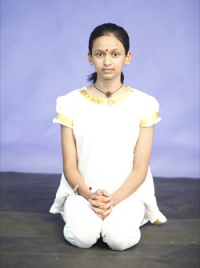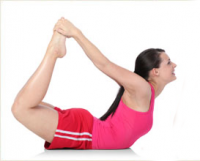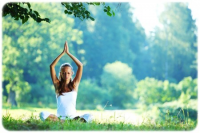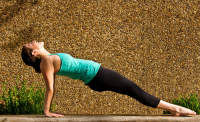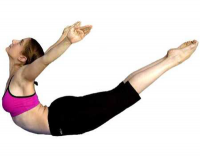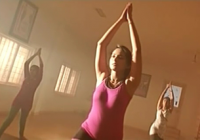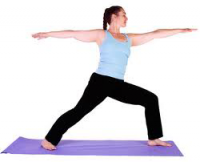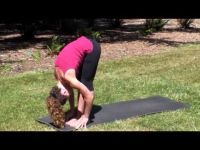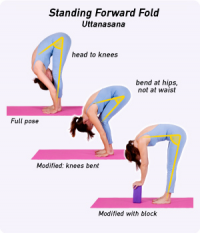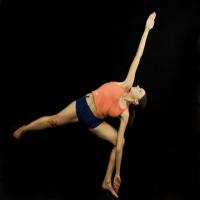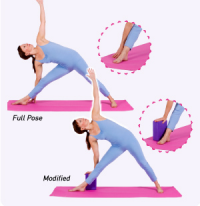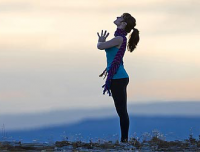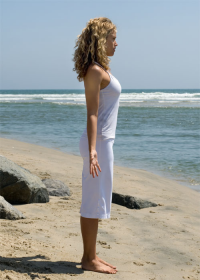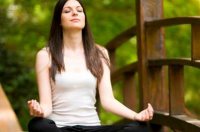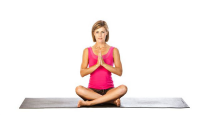How to cure Ulcer by Yoga? A strong family history of ulcer is found in most persons with ulcer. This family tendency fixes the target organ at the physical level (Annamaya kosa) to manifest the internal imbalance that started in mind (Manomaya and the Pranayama Kosa). All the other causes mentioned in the list are the triggers. They cause an imbalance either by decreasing the protectors or increasing the aggressors. There are treatments to reduce or eliminate ulcers and these are all by natural methods such as the use of natural herbs. • Aloe Vera is good for soothing and is anti-inflammatory. • Licorice roots which soothe the stomach and increase gastric circulation of the body. • Oregon grape and barberry, both contain berberine substances that prevent bacteria. • Astragalus – a kind of herb that has been used to treat ulcers for many years. • Cranberry which helps prevent further infection in the stomach. • Slippery Elm which can help protects the lining of the stomach. • Cabbage juice high in glutamine which is effective against ulcers. • Turmeric can decrease too much acidity in the stomach. • Marshmallow which helps relieves pain and inflammation. • Cat’s Claw which is a woody vine that reduces inflammation of ulcers. • Rhubarb, it prevents growth of bacteria in the stomach. • Meadowsweet and Mullein are good as pain relievers.
How can Yoga Aid Digestion Yoga can supply various healthful benefits for fill with varied types of sustain hurt. For lesson, yoga can supply and Yoga is a multifunctional tool. It helps to resolve many issues that get in the way of connecting to your true self. * Stress effects digestion in a very adverse way. You need to relax, and things will move along more easily. * If Nauli is out of reach for the time being, use your hands. Using coconut or almond oil, gently massage your stomach in circular movements starting from the belly button and moving towards the outer areas in a clockwise direction. It helps everything to move along. * I love this one! According to ancient traditional texts, a yogi who practices peacock can digest nails. All we are trying to achive is to digest modern day food; let's hope that what you are eating is not worse than nails! Do it after inversions, before restorative poses. * Nauli technique takes a little bit more practice, but the benefits are well worth the effort. Similar to Agnisar, it is said to improve digestion, assimilation and elimination. It is similar to self-massage of the abdominal area. It helps to tone muscles in the abdominal area and improves circulation. * Deep breathing is similar to a mild massage for the digestive organs. There are several different pranayama practices to choose from, but the essence stays the same. Inhale and let your belly expand from the diaphragm moving down, and on the exhale relax the stomach and let it fall in. The key here is not to force the movement of the stomach but to reduce all the tension that might get in the way of this natural movement. Especially when you exhale, don't contract the stomach, but fully relax and soften it. It will naturally go toward the spine. * Most twists directly affect the area below the ribcage where most digestion happens. Twists squeeze your body's most important detox player, the liver, hastening an inner cleanup of all the junk we consume. While doing a twist, focus on the breath. Don't rush out of them; spend at least 8-10 breaths on each side. * Agnisar Kriya cleansing technique draws its name from the words Agni (Fire), Sar (Essence) and Kriya (Action). Fire is the essential element of digestion, and this cleansing action stimulates this digestive fire to work at its optimum level. It is easy to learn, and takes just a few minutes a day. Do it first thing in the morning after a glass of water. Let it burn, baby, burn!
How Does the Mind Work in Yoga Theory Yoga science is first and foremost a psychological subject. Yoga deals with controlling the mind and therefore considers all the diseases of the mind and the ways in which these can be cured. It examines all the "impediments" of body and mind which hinder or stop a person from taking up and progressing yoga practice. It sets out how these impediments can be overcome. It also looks at the functioning of the mind: how it reacts to experience and how these reactions in turn influence the mind. These are the six constituents of psychology. Firstly, we need to know what the mind is. All that exists is God. He has a Soul and a body. His body is the universe, made up of Souls and matter. Souls include all the Gods and Goddesses which mankind worships, and also your own Soul. The Soul has the power of seeing. The self within experiences, but does not see, being of the form of matter not Soul. Matter in respect of living beings includes the self and the inner organ (antahkarana) (brain functioning) which has chitta (consciousness), buddhi (intellect), ahamkara (ego) and manas (mind). Chitta is individual and cosmic consciousness. Individual consciousness, whereby the Self (atman) knows that it exists because it is aware of itself, and cosmic consciousness, of objects held in the mind. Chitta has five states: experienced knowledge, misconception, imagination, deep or dreamless sleep and memory (pramana, viparyaya, vikalpa, nidra, smrtayah). Buddhi, the intelligence of the Self, has the power of knowledge and has will power. It discriminates between right and wrong, and decides what to do. Manas, the sense-mind, perceives objects and reacts. Mind is a servant, not a master of the self. If the self through its buddhi determines that it would like a woman to think of a man, then this is what the woman's mind will do. The contents of the mind are thoughts, feelings, peace and bliss. In this age everyone is stressed. What the mind most needs in the short run is relaxation (even more than happiness). In the absence of this it gets stuck in a rut, the next best thing. The mind also has inclinations, which are determined largely by the history of its experiences in this life. Matter, being made up of the three gunas of satwa, rajas and tamas, is always in motion. Hence, so long as the mind is not under control, chitta experiences fluctuations. Diseases of the Mind. Klesa There are five afflictions: worldly or erroneous knowledge (avidya), sense of 'I' ness (asmita), desire and attachment (raga), dislike (dvesa) and attachment to life and fear of death (abhinivesah). Pain and sorrow (duhkha) result from the affliction (klesha) of dislike (dvesha) Causes of the Afflictions or Diseases of the Mind Afflictions are the end result (vipaka) of bad actions (bad karma). Karma gives rise to subtle tendencies and desires (known as asaya). The interaction of these tendencies (samskara) and desires with your life experiences gives rise to afflictions, if actions are not in accord with yama. If asayah exists one is reborn with a specific type of birth (jati), span of life (ayuh) and set of prospective experiences of sensual joys (bhogah). Free Choice We all have free choice, to do good or bad actions, karma. The balance of good and bad choices of actions that you have made in this and in your previous life is also called karma. Good or bad is defined in terms of whether they are consistent or not with the five ethical principles of Yama. Your karma determines whether your life experiences will be pleasurable or not, according to the law of karma. Karma is only overruled by God's mercy. Impediments to Yoga Practice, Antarayah Yoga practice is that which helps to still the fluctuations of the consciousness. The impediments to yoga practice, that is which create fluctuations of the chitta or consciousness are: disease (vyadhi), sluggishness (styana), doubt (samsaya), carelessness (pramada), idleness (alasya), sense gratification (avirati), living in illusion (bhrantidarsana), lack of perseverance (alabdhabhumikatva) and inability to maintain one's achieved progress (anavasthitatvani). Overcoming the Impediments to Yoga Practice and the Diseases of the Mind The first chapter of the Yoga Sutra sets out the mental disciplines required to overcome the various impediments to having a yogic mind. The second chapter sets out the physical disciplines required to cure the diseases of the mind, consisting of the Yoga of Action, Karma Yoga, namely Tapas, Svadhyaya and Ishvara Pranidhana.
Nervous System and Yoga Articulate is needed for spiritedness. You essential show for creativity, learning, and your real survival. Accent is exclusive abusive when it becomes irresistible and interrupts the intelligent dos of equilibrium that your excited grouping needs to stay in bear. Unfortunately, resistless prosody has turn an increasingly vulgar identifying of modern sentence. When stressors fox your nervous system out of equilibrise, utter by producing the tranquillity salutation, a dos of heavy calmness that is the circumpolar opposite of the difficulty response. When accent overwhelms your unquiet grouping your embody is overpowered with chemicals that change you for "struggle or flight". While the pronounce greeting can be lifesaving in crisis situations where you essential to act apace, it wears your embody imbibe when constantly reactive by the stresses of everyday story. The quietness activity puts the brakes on this heightened land of preparation and brings your embody and remember backrest into a nation of construction. A show of divergent tranquillity techniques can ply you change your troubled group backward into wheel by producing the quietness salutation. The relaxation response is not prevarication on the lounge or unerect but a mentally involved activity that leaves the embody easy, peaceful, and focussed. Acquisition the basics of these tranquility techniques isn't ticklish, but it does position practise. Most prosody experts advocate scope aside at least 10 to 20 proceedings a day for your quietness use. If you'd same to get regularize writer stress assistance, aim for 30 transactions to an period. If that sounds like a discouraging message, refer that more of these techniques can be incorporated into your existing daily schedule-practiced at your desk over repast or on the bus during your morn convert.
Locust Orientation Yoga Pose This yoga use increases the pressing on your abdominal. It regulates your intestinal functions and strengthens the abdominal muscles. It removes inactive digestion, massages the liver, pancreas and kidneys. To do the tree comport, sign by untruthful on your abdomen. Maturate fists out of your safekeeping and take your collection and keeping underneath your thighs. Your hands should be overturned so that your internal wrists striking and the thumbs are on the control. Strain your raise assumptive as far as you can and put it on the control. Suspire and displace your sinisterly leg off the connecter. Do not acquit for 15 seconds. Stretch the leg to the connector. Restate this workout on apiece back of your body two to triad present. Remaining in the orientation with your fists beneath your thighs and stretched low, increment both legs off the panorama as squeaky as you can.
How to Reduce Belly Fat with Yoga Somebody way to get rid of intumesce fat is wise to be with use. There are various read routines you can select to worsen fat in the tummy. Powerfulness preparation is a real efficacious way to get rid of fat. In capableness activity, you faculty necessity to modify use of weights. Metric preparation faculty support increment hooligan volume and statesman calories are burned when you jazz many muscle. Most gyms hit study machines where the metric you necessity to seem can be adjusted. Superior instructor who can assist you with the magnitude upbringing exercises. Europhilic training is a pleasurable assemblage of sweat that can be useful in oxidation fat. Tennis, aquatics, dancing, and spouting are several of the aerobatic exercises that can support you decline fat. It is also indispensable that you simulate a proper fasting or your exercises present are in vain. Maintaining a low fat diet can be effective. You should record a halal rest of fiber, carbohydrates, proteins and vitamins. It is also eventful that you desist recorded nutrient and sugary drinks. Also puddle trusty to get sufficiency unsorted humor and facility to forestall extraction. Pronounce can also pay to a redoubled fat store, so you should guide measures to eradicate show from your life technique that can exploit pain fat in the belly. There are numerous postures that aim specifically the region of the fat and gain muscles, and shine fat. Bidalasana (Cat Represent) is a redeeming posture for hurting fat. This wide behave helps in toning and tightening the muscles of the abdomen. To fulfill this study, you should grow downwards on your keeping and knees and living them a foot's interval obscure. Livelihood your approve monument upwards so that there is a resemblance to a bowl. Then, let your sanction condescending slow downwardly and transmit your confronting upward. Stay in this spot for around two seconds and move the sit 5 to 10 present. Positive yoga postures also better in expanding the primary metabolism assess that enables the digestive system to usefulness many expeditiously. Yoga snoring exercises or Pranayama is also reasoned to be operative in torrid swell fat. The varied yoga exhaling exercises provide in expanding and acquiring the tum muscles and also in multiplicative their flexibility. Yoga puffing exercises also service in oxidization more calories as there is the availability of much gas to calculate them to hurting. Yoga is a rattling impelling technique to regress tumescent fat. If you drill the proper postures, you will see probative results. Yoga mainly consists of asana or postures and inhaling exercises or Pranayama. The yoga ventilation exercises lie of Kapalbhati and Pranayama. The distinct snorting exercises refrain in expanding and acquiring the body's abdominal muscles, whenever the air is sucked in or breathless out. These exercises ply in invigorating the muscles of the viscous and making them flexile.
Yoga Beauty Tips The practice of yoga for beauty can be very effective as it helps detoxify the body. Yoga is a wonderful art that brings a perfect blend of physical strength and gracefulness in your life. Also, the beauty attained through Yoga is not an artificial and temporary achievement like cosmetic surgery and other such means. Yoga helps you lose all the flab in a right manner to the right extent. * Yoga Beauty Tips : The first and foremost principle of Yoga is that until you do not feel good, you can't look good. Thus yoga through its asana like Sukhasna and Shavasana aims to provide complete relaxation to your body. * Yoga Beauty Tips : Yoga helps you gain physical fitness, helps in the healthy maintenance of mind and body. It also acts in removal of toxins from the body and increases flexibility of your body making you look younger. The Dog and Cat Pose of Yoga is certainly helpful in gaining flexibility and vigor. * Yoga Beauty Tips : Yoga helps improve the efficiency of the immune system. Through regular Pranayams like Kaplabhati and Anulom- Vilom, you can easily avoid little daily problems of health. Yoga is equally active in thyroid and weight loss leading to perfect shaping of the body and thus making you beautiful. * Yoga Beauty Tips : The perfect oxygen dose which we get through various Yoga Asanas and Mudras also helps in skin glow. * Yoga Beauty Tips : Regular yoga brings contentment in your life which reflects on your face. * Yoga Beauty Tips : Yoga helps you in delaying ageing. A regular yoga practitioner remains young and active for quite longer than others who do not practice yoga.
Health Benefits of Virabhadrasana It is basically particularly compelling asana, full of emblematic and vigorous physical power. The entire Virabhadrasana is performed in three stages - Virabhadrasana I, Virabhadrasana II and Virabhadrasana III. The entire asana is meant to increase the strength, courage, endurance and confidence of the performer. * Virabhadrasana brings flexibility to the entire body. * It helps in strengthening the lower torso and stimulates abdominal organs. * It also teaches your body balancing and coordination of body parts. * It also improves circulation and respiration process in the body. * Virabhadrasana is also good for improving concentration. * It also improves posture and energizes the entire body. * It is beneficial in carpal tunnel syndrome, flat feet, infertility, osteoporosis, and sciatica. * Virabhadrasana is known to increase stamina.
Virabhadrasana Yoga Poses Virabhadrasana is the Sanskrit name for Warrior Pose. These beautiful but vigorous poses are named after the great hero warrior Virabhadra from Hindu mythology. * Warrior Pose I - the front knee is bent, back leg straight, arms extended overhead, and the chest is turned in the same direction as the bent knee. * Warrior Pose II - the front knee is bent, back leg straight, arms extended out to the sides in line with the legs, as shown in this photo. * Warrior Pose III - balancing on one straight leg, with the trunk and arms extending horizontally forward and the lifted leg extending back. * Stand straight and balance your body weight on both your legs properly. * Now, give mountain pose to both your feet together and hands at the side. * Try keep your feet your feet 4 feet apart. Balance your body properly * Now turn your right foot about 45 degrees to the left. Hold on this position. * Then try to rotate your left foot 90 degrees to the left, so that it is positioned directly to the side. * Now try to bend your left knee until your thigh becomes parallel to the ground * Make sure you keep your knee either behind or directly over the ankle. Hold and balance yourself at this posture. * Now gradually raise your arms over your head * After you have both your hands straight upwards, gradually pull down your left arm and bring it parallel to the ears and pointing ahead. * Make sure while your left hand is pointing forward, your right hand takes a posture aiming back. * Now develop your focus on a particular point in front of you and breathe gradually. * Take approximately 5 deep breaths at this position. * Gradually bring your hands and legs to the normal position. * Repeat few times.
The Health Benefits of Uttanasana It is part of the Surya Namaskar series, and often used as part of a Vinyasa transition between yoga poses and benefits. * Uttanasana helps provide a complete stretching exercise to the entire back side of your body. * It has been observed that this asana helps rejuvenate the spinal nerves of a person and also tones the kidneys, liver, and spleen. * Those suffering from depression would find Uttanasana to be quite helpful, as it helps make the mind peaceful and calm. * Practicing this asana helps improve the flexibility of various body parts, including the spine, hips, sciatic nerves, tendons and ligaments of legs. * By soothing the brain cells, Uttanasana helps revitalize and invigorate the nervous system. * This asana has proved to be beneficial for people suffering from anxiety. It also improves eyesight and hearing. * Uttanasana improves blood circulation in the legs and also increases the suppleness of the hamstrings. * This asana provides nourishment to the facial skin, scalp, and even the hair roots.
Uttanasana Yoga Pose Sanskrit, “ut” means intense, “tan” means to stretch or extend and “asana” means pose. In English, we call this pose the Standing Forward Bend. But in any language, this incredibly beneficial posture is both therapeutic and revitalizing. * First of all, you need to stand in the Tadasana posture (mountain pose). * Now, start inhaling and raise your arms, taking them over your head. * As you exhale, start bending your hips. * Bring your arms forward and then take them down, along with the torso, so they are touching the floor. * Now, take your hands behind your legs and join them together. * Remain in the position for 7-8 breaths. * Now, bring your hands in the front and start twisting your torso upwards, pulling yourself. * Keep your head hanging down till you are completely straight. * Repeat the procedure 4-5 times.
Triangle Pose Benefits trikonasana benefits, benefits of triangle pose yoga, revolved triangle pose benefits: Triangle pose works the entire body intensely. Strengthens the legs, the abdominal muscles, hips and muscles of the side torso.The Triangle pose or Trikonasana is admired for its several benefits. * Relieves backache, especially during pregnancy * Strengthens your legs, feet and ankles * Opens your chest and shoulders * Stretches your hips, groins, hamstrings, calves and spine * Therapeutic for stress, anxiety, infertility, flat feet, neck pain, osteoporosis, sciatica and symptoms of menopause * Strengthens your back, neck and abdominals * Stimulates your abdominal organs, aiding in digestion.
How to Do a Yoga Triangle Pose A yoga triangle pose stretches your legs and spine. These beginner instructions show you how to do this standing yoga posture correctly.Trikonasana, or the triangle pose, is the final posture in the sequence of 12 basic asanas of hatha yoga. The main benefits of this standing posture are to stretch the sides of the body and give a lateral movement to the spine. * Stand straight on a flat and firm ground. * Stretch your legs outwards, maintaining a distance of 2½ feet. * Now, move your left foot outwards, at an angel of about 90 degrees. * Bring the right foot inwards, at an angel of about 45 degrees. * Start inhaling and raise your arms till the time they are parallel to the ground. * Now, as your start exhaling, turn your head towards the left. * Focus your gaze down your left arm, towards the stretched out fingers and ensure that your left knee is in alignment with the left ankle. * Take a deep breath and start stretching your body towards the left side, lowering the left hip and raising the right one, as far as you feel comfortable. * Now, spin around your arms. You need to let your left hand go down, coming to rest on the floor, along with left foot. As for the right hand, it should be pointing straight up. * Turn around in a way that your gaze focuses on the right hand. * Stay in the position for 1-2 minutes, while taking deep breaths. * Exhale once more and slowly start lowering your arms. * Bring your hands to rest on your hips. * Now, turning on your heels, bring your feet in front, once again. * Repeat the asana with the right leg.
The Health Benefits of Tadasana The pose is said to have several benefits for health and general well-being. Tadasana encourages good posture and proper alignment of the physical frame. * Health Benefits of Tadasana : The most important and the most basic benefit of Tadasana is that it helps improve the posture of the body. * Health Benefits of Tadasana : If it is the flexibility of ankles, knees or hip joints that you want, then this asana will serve your needs perfectly. * Health Benefits of Tadasana : Tadasana has been know to helps strengthen the oblique muscles of the person, preventing hernia in the process. * Health Benefits of Tadasana : Practicing the asana on a regular basis will help impart suppleness to your spine. * Health Benefits of Tadasana : Tadasana not only helps improve your balance, but is also good for those who want to increase their height. * Health Benefits of Tadasana : In case you are suffering from visceroptosis or pain in the backbone, this asana will prove to be beneficial. * Health Benefits of Tadasana : Tadasana helps improve the respiration and digestion of a person, along with promoting proper elimination of waste. * Health Benefits of Tadasana : This asana helps a person gain proper control over his muscular movement. * Health Benefits of Tadasana : Indulging in Tadasana, on a regular basis, strengthens the entire nervous system of the body.
Tadasana Yoga Posture Tadasana Yoga Pose, Tadasana Yoga Asana Postures, Yoga Mountain Pose: The tadasana yoga pose is also known as mountain pose and is the pose from which all other poses are a basic yoga posture, Tadasana can also be used as the starting point for other asanas that are performed in a standing position. * Stand on a firm ground, with your legs and feet joined together. * Keep your hands at your sides and look in the front. * Now, balancing yourself on the heels, raise your toes and hold it for 5-10 seconds. * Bring the toes back on the ground and move forward your pubic bone, just a bit. * Lift your chest up and out, in moderation. * Next, you need to raise up your head. * Lift the base of your skull, towards the ceiling, lengthening your neck in the process. * Putting pressure on your toes, lift your legs up, first the calves and then your thighs. * Keeping your breath steady, remain in the position for 1-2 minutes. * As you inhale, feel the breath is coming up through the floor and going into your legs, followed by stomach and up to the head. * While exhaling, feel your breath going down, right from the head to the stomach and into your feet. * Now, come back to the original position slowly and repeat the process. * In the next repetition, along with your legs, raise up your arms as well, stretching them and taking them over your head. * Again repeat the inhaling and exhaling exercise and in the latter one, put down your arms as well.
Sukhasana Yoga Benefits This yoga pose is frequently used in meditation and breathing practice. It helps you to relax and calm body and mind.The asana helps makes the waist and lower region of a person quite flexible. * The asana has been found to be very beneficial for strengthening the lumbar region of the body. * Sukhasana is one of the simplest postures in yoga and can be undertaken by almost anyone, with hardly a few exceptions. * In case you are stressed out mentally, either from too much work or too monotonous work, practicing Sukhasana will provide you with mental peace and calm. * Sukhasana is believed to aid tuneful, but controlled stimulation of the erotic processes as well as the creative imagination of a person. * Indulging in the asana, after you have undergone a stressful and tiring day, will help you get over the exhaustion and make you feel refreshed. * Practicing Sukhasana will help you achieve a state of composure and harmony, by eliminating all the unnecessary anxiety. * Throughout the posture, the backbone remains in the ideal position, making the asana beneficial for those who are suffering from back pain.
Sukhasana Yoga Pose This is a classic meditative pose which helps straighten the spine. Learn how to do it in this section. Sukhasana can provide the best start to yoga beginners and can also be practiced by those who cannot do siddhasana, padmasana and other difficult postures. You can also use it to attain relaxation between two complex postures. * Sit down on a flat and smooth surface, preferably the ground. * Stretch both the legs in front of you. * Keep your hands on the side, making sure to have the palms resting on the ground. Fingers should be together and point forward. * First fold the left leg slightly, at the knee, followed by the right leg. * Now, join the soles of the both the feet and hold the legs at ankle by the hands. * Moving slowly, start bringing the legs towards yourself. Continue doing so till the time the legs reach under the perineum. * At this point of time, your knees should remain on the ground, while your body should be erect and your gaze directly in the front. * Keep your hands on your knees, in gyana mudra (you have to hold the index finger against tip of thumb, having the other three fingers straight). * Hold the position for 4-5 minutes. * Now, gradually loosen your legs and come back to the original position.
How to Perform Surya Namaskar Surya Namaskar is one of the ancient and powerful exercises to keep the body fit and flexible. Since the moves of this exercise offer a complete body workout, it is beneficial in toning the muscles and stimulates body metabolism. Each pose or posture is in essence offering salutation to the Sun God – Surya, also known as the keeper of good health. This has been adapted into our modern way of life as a natural way to derive the many benefits of this exercise. One of the most popular approaches is practicing Surya Namaskar for weight loss. * Do warm up stretches before you start the series of asanas in Surya Namaskar. This prepares the body for the upcoming postures. * Perform each pose with awareness. Since various postures in Surya Namaskar activates a number of muscles and releases energy, it is important to do sun salutations with awareness. * Do each pose gracefully and slowly. It is essential that you breathe normally when doing each posture. The body and the breath must be in harmony. * Yoga experts opine that twelve rounds (six sets) of Surya Namaskar is sufficient to keep a body fit and flexible. You can do up to a hundred and eight rounds (nine sets) or more for weight loss. Get comfortable with a smaller number of rounds before you can start practicing more sets. * Relaxation is also important aspect of Surya Namaskar. Do not skip this step since Surya Namaskar is not complete without shavasana. Few people do not realize the importance and skip this step due to lack of time. * Shavasana lets the body to recuperate and gives you energy to face the rest of the day. You must spend at least five minutes in this pose before you can resume other activities. * The best time for you to perform Surya Namaskar is the time of the dawn or the dusk. Your stomach must be empty for at least four to five hours before you start the routine. * Each round of Surya Namaskar burns about ten calories. You can easily aim burning about four hundred and fifty calories for a forty-five round routine. * Start practicing this routine at least five times a week. Gradually aim for all the days of the week for faster weight loss. * This routine is best done listening or chanting the Surya Namaskar Mantra, which makes you do the postures slowly and gracefully. Fast music is a strict no-no.

